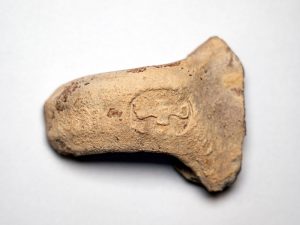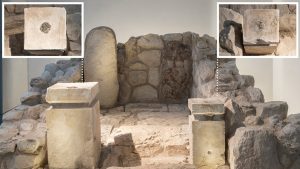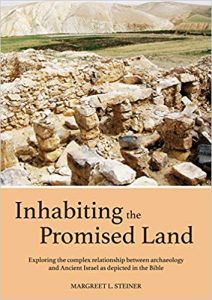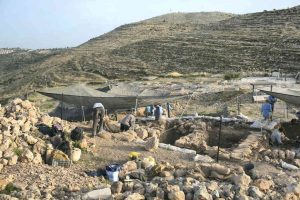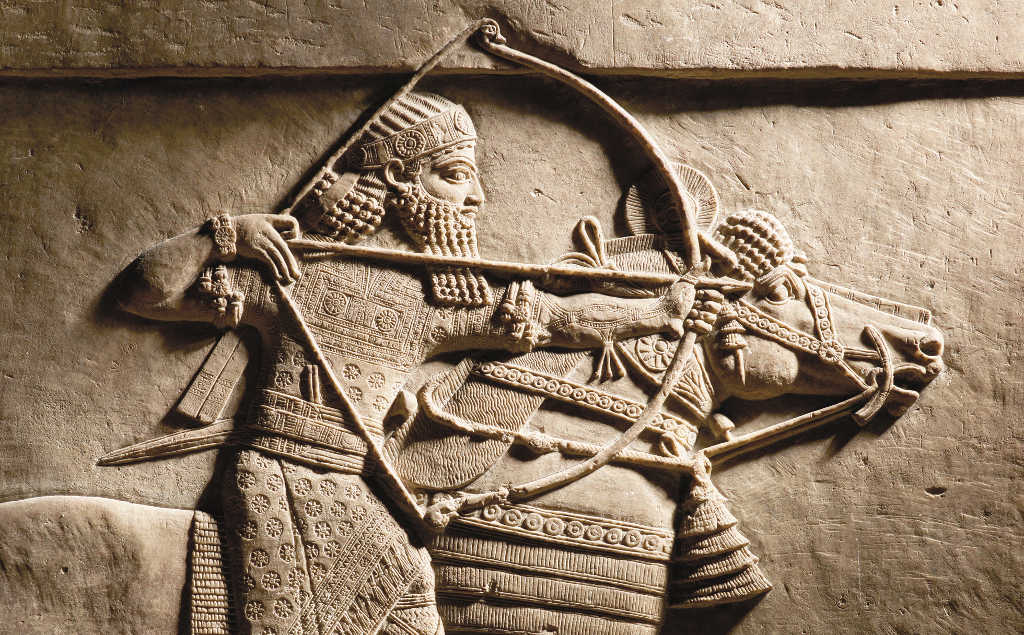Em minha História de Israel escrevi: Palestina é um nome derivado de “filisteus”, em hebraico pelishtim, um povo que habitava a faixa costeira situada entre o Egito e a Fenícia. Os filisteus são de origem egeia, talvez de Creta. Faziam parte dos “povos do mar”, que após 1177 a.C., mais ou menos, tentaram invadir o Egito, mas foram vencidos pelo faraó Ramsés III e passaram a viver naquela parte da Palestina.
Agora foi divulgado que uma equipe de pesquisadores usando avançadas tecnologias de DNA em amostras antigas de ossos encontrados durante escavações feitas em Ascalon, na costa palestina, de 1985 a 2016, e analisando os dados genômicos recuperados de pessoas que ali viveram durante as Idades do Bronze Recente e do Ferro (cerca de 1600 a 900 a.C.), descobriu que uma proporção substancial de seus ancestrais era derivada de uma população europeia. Essa ancestralidade derivada da Europa foi introduzida em Ascalon por volta da época da chegada estimada dos filisteus no século XII a.C. Os resultados do estudo foram publicados na revista Science Advances.
Ancient DNA sheds light on the origins of the Biblical Philistines
An international team, led by scientists from the Max Planck Institute for the Science of Human History and the Leon Levy Expedition, retrieved and analyzed, for the first time, genome-wide data from people who lived during the Bronze and Iron Age (~3,600-2,800 years ago) in the ancient port city of Ashkelon, one of the core Philistine cities during the Iron Age.
The team found that a European derived ancestry was introduced in Ashkelon around the time of the Philistines’ estimated arrival, suggesting that ancestors of the 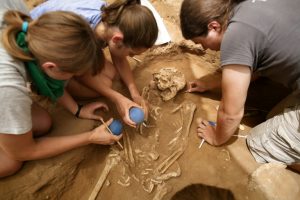 Philistines migrated across the Mediterranean, reaching Ashkelon by the early Iron Age.
Philistines migrated across the Mediterranean, reaching Ashkelon by the early Iron Age.
This European related genetic component was subsequently diluted by the local Levantine gene pool over the succeeding centuries, suggesting intensive admixture between local and foreign populations. These genetic results, published in Science Advances, are a critical step toward understanding the long-disputed origins of the Philistines.
The Philistines are famous for their appearance in the Hebrew Bible as the arch-enemies of the Israelites. However, the ancient texts tell little about the Philistine origins other than a later memory that the Philistines came from “Caphtor” (a Bronze Age name for Crete; Amos 9:7).
More than a century ago, Egyptologists proposed that a group called the Peleset in texts of the late twelfth century BCE were the same as the Biblical Philistines. The Egyptians claimed that the Peleset travelled from the “the islands,” attacking what is today Cyprus and the Turkish and Syrian coasts, finally attempting to invade Egypt.
These hieroglyphic inscriptions were the first indication that the search for the origins of the Philistines should be focused in the late second millennium BCE. From 1985-2016, the Leon Levy Expedition to Ashkelon, a project of the Harvard Semitic Museum, took up the search for the origin of the Philistines at Ashkelon, one of the five “Philistine” cities according to the Hebrew Bible.
Led by its founder, the late Lawrence E. Stager, and then by Daniel M. Master, an author of the study and director of the Leon Levy Expedition to Ashkelon, the team found substantial changes in ways of life during the 12th century BCE which they connected to the arrival of the Philistines. Many scholars, however, argued that these cultural changes were merely the result of trade or a local imitation of foreign styles and not the result of a substantial movement of people.
This new study represents the culmination of more than thirty years of archaeological work and of genetic research utilizing state of the art technologies, concluding that the advent of the Philistines in the southern Levant involved a movement of people from the west during the Bronze to Iron Age transition.
Genetic discontinuity between the Bronze and Iron Age people of Ashkelon
The researchers successfully recovered genomic data from the remains of 10 individuals who lived in Ashkelon during the Bronze and Iron Age. This data allowed the team to compare the DNA of the Bronze and Iron Age people of Ashkelon to determine how they were related.
The researchers found that individuals across all time periods derived most of their ancestry from the local Levantine gene pool, but that individuals who lived in early Iron Age Ashkelon had a European derived ancestral component that was not present in their Bronze Age predecessors.
“This genetic distinction is due to European-related gene flow introduced in Ashkelon during either the end of the Bronze Age or the beginning of the Iron Age. This timing is in accord with estimates of the Philistines arrival to the coast of the Levant, based on archaeological and textual records,” explains Michal Feldman of the Max Planck Institute for the Science of Human History, leading author of the study. “While our modelling suggests a southern European gene pool as a plausible source, future sampling could identify more precisely the populations introducing the European-related component to Ashkelon.”
Transient impact of the “European related” gene flow
In analyzing later Iron Age individuals from Ashkelon, the researchers found that the European related component could no longer be traced. “Within no more than two centuries, this genetic footprint introduced during the early Iron Age is no longer detectable and seems to be diluted by a local Levantine related gene pool,” states Choongwon Jeong of the Max Planck Institute of the Science of Human History, one of the corresponding authors of the study.
“While, according to ancient texts, the people of Ashkelon in the first millennium BCE remained ‘Philistines’ to their neighbors, the distinctiveness of their genetic makeup was no longer clear, perhaps due to intermarriage with Levantine groups around them,” notes Master.
“This data begins to fill a temporal gap in the genetic map of the southern Levant,” explains Johannes Krause of the Max Planck Institute for the Science of Human History, senior author of the study. “At the same time, by the zoomed-in comparative analysis of the Ashkelon genetic time transect, we find that the unique cultural features in the early Iron Age are mirrored by a distinct genetic composition of the early Iron Age people.”
Fonte: Archaeology News Network – 03/07/2019
Em 2016 a BBC já havia publicado o seguinte:
Arqueólogos fazem ‘descoberta inédita’ de cemitério filisteu em Israel – BBC News Brasil: 10 julho 2016
Pesquisadores em Israel afirmam ter descoberto um cemitério filisteu – seria, segundo eles, o primeiro a ser encontrado na história.
O achado, ocorrido em 2013 e tornado público neste domingo, pode trazer respostas sobre o antigo mistério em torno da origem do povo.
A descoberta marcou o fim da escavação realizada pela Expedição Leon Levy na região do Parque Nacional de Ashkelon, no sul de Israel. Os trabalhos duraram 30 anos.
Os líderes da pesquisa dizem ter encontrado 145 conjuntos de restos mortais em várias câmaras fúnebres, algumas cercadas por perfume, comida, joias e armas.
As ossadas são originárias do período compreendido entre os séculos 11 a.C. e 8 a.C.
Povo migrante
Os filisteus são mencionados na Bíblia como arqui-inimigos dos antigos israelitas.
Acredita-se que eles tenham migrado para as terras de Israel por volta do século 12 a.C, vindos de áreas do oeste.
O filisteu mais famoso nos dias atuais é Golias, guerreiro gigante que, segundo o livro sagrado, foi vencido pelo jovem Davi antes de ele se tornar rei.
“Após décadas estudando o que os filisteus deixaram para trás, nós finalmente ficamos cara a cara com essas pessoas”, afirmou Daniel M. Master, um dos líderes da escavação.
“Com essa descoberta, nós estamos próximos de desvendar o segredo em torno de suas origens.”
Segredo de três anos
O achado foi mantido em segredo por três anos até que os trabalhos fossem finalizados. O objetivo era evitar atrair a atenção de ativistas judeus ultraortodoxos, que já haviam feito atos contra escavações.
Os manifestantes acusavam os arqueólogos de perturbar locais de sepultamento.
“Nós tivemos que segurar as nossas línguas por um longo tempo”, disse Master.
Especialistas que estudaram o período divergem sobre a origem geográfica dos filisteus – Grécia, sua ilha Creta, Chipre e Anatólia, na Turquia, são apontados.
A equipe da expedição está agora fazendo exames de DNA, de datação por radiocarbono e outros testes nos restos mortais em uma tentativa de apontar com previsão sua ascendência.
A maioria dos corpos não foi enterrada com itens pessoais, afirmam os pesquisadores, mas perto de alguns havia utensílios onde eram guardados perfumes, jarras e pequenas tigelas.
Poucos indivíduos foram sepultados com pulseiras e brincos. Outros, com armas.
“É assim que filisteus tratavam seus mortos, e esse é o ‘livro de códigos’ para decifrar tudo”, disse o arqueólogo Adam Aja, um dos participantes da escavação.
DNA dos filisteus mostra suas origens europeias – AFP: 03/07/2019
Esqueletos antigos encontrados em Israel e analisados na Alemanha podem ser a chave para resolver o enigma do povo filisteu e estabelecer suas origens europeias pela primeira vez através da análise de seu DNA, de acordo com cientistas.
Esta descoberta sobre as origens deste povo estabelecido na antiguidade no sudoeste de Canaã, em uma faixa de terra que atualmente fica entre Tel Aviv e Gaza, foi publicado nesta quarta-feira (3) na revista Science Advances, e qualificada como “extraordinária” por um dos arqueólogos do projeto.
Até agora, os cientistas não tinham nenhuma informação que permitisse traçar a origem dos filisteus. Só sabiam que chegaram a esta região semita por volta do século XII a.C.
Os escritos bíblicos e egípcios os incluíam nos chamados “povos do mar”. Suas cerâmicas vermelhas e negras, assim como sua arquitetura, poderiam relacioná-los com as civilizações presentes no Mar Egeu.
“A ideia segundo a qual os filisteus eram migrantes nunca antes pôde ser demonstrada”, explica Daniel Master, que dirigiu a equipe arqueológica que fez escavações em Ascalon, uma das cinco cidades filisteias localizadas atualmente no sudoeste de Israel.
As ossadas encontradas em Ascalon, da Idade do Bronze e do Ferro, foram analisadas graças a avançadas tecnologias na Alemanha.
Ao comparar o genoma das ossadas dos dois períodos, “descobrimos que os filisteus, que estavam presentes na Idade do Ferro, tinham uma parte de seu genoma que não existia nos povos que viviam ali antes, na Idade do Bronze”, destaca Michal Felman, uma das pesquisadoras do Instituto Max Planck para as ciências da história humana em Jena, Alemanha.
“Esta parte do genoma parece derivar de um genoma europeu”, acrescentou.
“Há 150 anos arqueólogos de todo o mundo trabalham sobre este tema”, destaca por sua vez Daniel Master, que qualifica a descoberta como “extraordinária”.
“Agora, com os resultados do DNA à nossa disposição, que mostram um aporte de origem europeia em Ascalon no século XII a.C. podemos dizer (…) que estas pessoas eram migrantes vindos a esta região no século XII”, destacou.
– Primeira migração rastreada –
A equipe de Daniel Master descobriu em 2013 um cemitério filisteu em Ascalon do qual se pôde obter uma ampla diversidade de amostras de DNA para ser analisadas pelos arqueogeneticistas.
Os resultados, no entanto, não tinham sido publicados até agora, já que os métodos que permitiam este tipo de investigação não estavam disponíveis antes, assegura Michal Feldman.
Os cientistas podem averiguar a origem dos filisteus “na Europa e provavelmente no sul da Europa”, mas “ainda não têm suficientes dados para identificar a população exata”, destaca.
As razões que levaram os filisteus a se instalar no litoral ensolarado do leste do Mediterrâneo por volta do fim da Idade do Bronze continuam sendo, no entanto, um mistério.
Mas segundo Daniel Master, durante o século XIII a. C. ocorreram várias migrações rumo ao leste do Mediterrâneo. É a primeira vez que os cientistas conseguiram rastrear uma delas, afirma.
Os filisteus, experientes comerciantes e marinheiros, não praticavam a circuncisão e comiam carne de porco e de cachorro, como demonstram os ossos encontrados nas ruínas das outras quatro cidades filisteias vizinhas (Gat, Gaza, Ashdod e Ekron), que formavam seu Estado.
Esta população desapareceu por volta de 600 a.C., quando os babilônios conquistaram a região.
Sua história foi sobretudo transmitida por seus vizinhos e inimigos, os israelitas, na Bíblia, onde são mencionados em tons muito negativos.
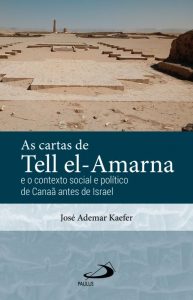 relações políticas e econômicas que existiam entre o Egito e os reinos da Mesopotâmia e de Canaã, no final do segundo milênio a.C. Por oferecer importantes informações não só sobre o Egito, mas também sobre os grandes reinos do Antigo Oriente Próximo, todo o material encontrado em Amarna tornou-se uma importante chave para compreendermos melhor a cultura pré-bíblica e a história dessa região, na qual teve origem o povo de Israel.
relações políticas e econômicas que existiam entre o Egito e os reinos da Mesopotâmia e de Canaã, no final do segundo milênio a.C. Por oferecer importantes informações não só sobre o Egito, mas também sobre os grandes reinos do Antigo Oriente Próximo, todo o material encontrado em Amarna tornou-se uma importante chave para compreendermos melhor a cultura pré-bíblica e a história dessa região, na qual teve origem o povo de Israel.
